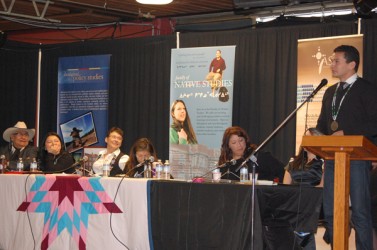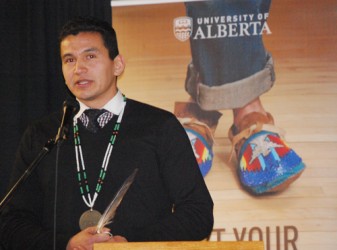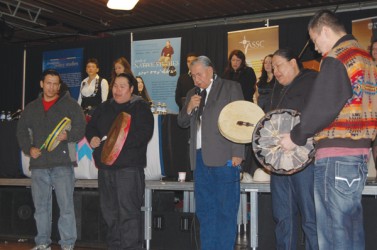Article Origin
Volume
Issue
Year
When grassroots First Nations people were pushing Harper for answers, the Assembly of First Nations gave the Prime Minister a way out.
“I’m not putting a value judgement on that,” said Wab Kinew, director of Indigenous Inclusion at the University of Winnipeg.
Kinew was referring to the thousands of mainly Indigenous people who gathered throughout the months of December and January to protest omnibus Bills C-38 and C-45, which brought in changes to legislation on how First Nations business is conducted and to legislation controlling development that impacts the environment.
While rallies took place at provincial legislatures, Parliament Hill and other sites, Prime Minister Stephen Harper met with representatives from a divided AFN membership, which presented him with an 11-point document. The outcome of the meeting was a pledge by Harper to work with First Nations at a high level.
“We have to be politically pragmatic. That means we have to understand that when you put political pressure on a group of people they are going to seek a way to resolve the situation. I was just presenting an analysis that presents the Assembly of First Nations in these last few weeks as being that sort of help for the federal government,” said Kinew.
Kinew said the actions of Idle No More, which represents the grassroots, and AFN, led by National Chief Shawn Atleo, are not at cross-purposes, but rather there is a “disconnect” between the values being pushed by the AFN executive and the priorities set by the Idle No More movement.
“So what I’m suggesting is that Idle No More needs to engage and either present an alternative emissary for the federal government to deal with or work with the AFN to make sure that the priorities of the people you see coming out to the grassroots events are shared by the people at the Assembly of First Nations.”
Kinew believes that the AFN is the representative body for the chiefs.
“So there is a vacuum for who is the national voice for the average person on the street. Who do they vote for? They vote for their leaders, but do they have a direct vote in any national leader?” asked Kinew.
He says it is also unclear as to who represents the other Aboriginal people, especially those who live in urban areas.
“So Idle No More, if we are successful in getting a lot of this energy to translate into political action, it will result in sort of a new voice. I’m not saying necessarily that’s going to replace any existing organization. It might come and rise up within one of these existing organizations. But really, what we’re seeing is that people in the grassroots have a direction and there’s a little bit of tension between where their politicians want to go and where (the grassroots) want to go.”
Kinew sees the differences in opinion and the way of doing business between Idle No More and the AFN as a healthy part of democracy.
“I don’t think we’re divided because I don’t consider there is anyone at AFN to be on the opposite side from me. I consider them to be my allies. And I hope they would look at me in the same way. So really the way I would look at the process right now is that we are in the midst of consensus building,” he said.
Idle No More has captured the spirit of the Indigenous people, at both the levels of the heart and head, and what makes the movement so attractive is its lack of infrastructure: no office space, no budget.
“But at the end of it, hopefully we stay committed to who this is really about. It’s not about me. It’s not about the politicians. It’s about little kids in the communities and it’s about making changes for them. Hopefully we keep those kids in mind and we’re able to forge a common direction for them,” said Kinew.
- 14707 views



